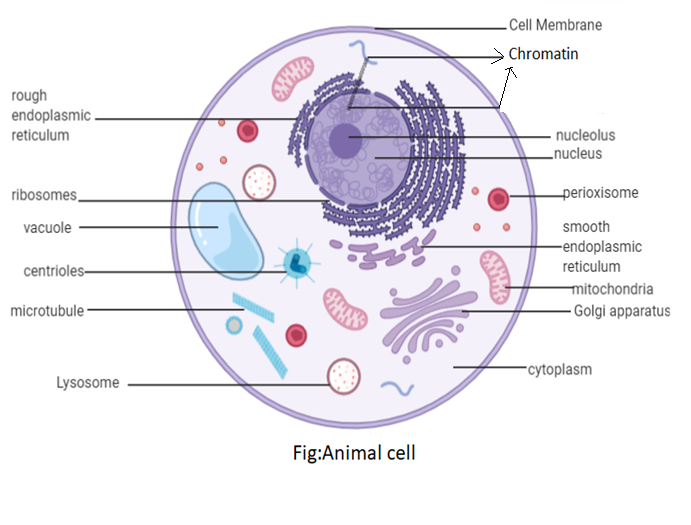
Draw a neat labeled diagram of animal cells.
Answer
543.6k+ views
Hint: Animals are complicated organisms. While animals exhibit locomotion, plants are sessile. Animals can't synthesize their food.
Complete step by step answer:
A cell is a living organism's fundamental structural and functional unit. A cell is the essential building block of life, that keeps anything alive and is self-sufficient to execute all of an organism's fundamental functions, as per the postulates of cell theory.
The cellular components are called cell organelles. In these cell organelles, both membrane and non-membrane bound organelles, present inside the cells, are included and are different in their structures and functions. Cell organelles are called cellular elements. Both membrane and non-membrane bound organelles, found within the cells, are included in these cell organelles and are distinct in their structures and functions.
A few of them operate by offering form and protection, while others are involved in a cell's locomotion and reproduction. Within the cell, there are different organelles and they are divided into three groups based on the presence or absence of the membrane.
The cell wall, ribosomes, and cytoskeleton are organelles of cells that are non-membrane-bound. Both prokaryotic cells and eukaryotic cells are present.
Vacuole, Lysosome, Endoplasmic Reticulum, Golgi Apparatus, are single membrane-bound organelles found only in eukaryotic cells. Double membrane-bound organelles found only in eukaryotic cells are the nucleus, mitochondria, and chloroplast.

Note: The ability to execute photosynthesis is typically seen in organisms belonging to the Plantae kingdom, but photosynthesis can also be done by some other organisms belonging to the Monera kingdom, the Protista kingdom, etc. Euglena is an organism that exhibits characters that are both plant and animal-like, and a mixotrophic nutrition mode is observed.
Complete step by step answer:
A cell is a living organism's fundamental structural and functional unit. A cell is the essential building block of life, that keeps anything alive and is self-sufficient to execute all of an organism's fundamental functions, as per the postulates of cell theory.
The cellular components are called cell organelles. In these cell organelles, both membrane and non-membrane bound organelles, present inside the cells, are included and are different in their structures and functions. Cell organelles are called cellular elements. Both membrane and non-membrane bound organelles, found within the cells, are included in these cell organelles and are distinct in their structures and functions.
A few of them operate by offering form and protection, while others are involved in a cell's locomotion and reproduction. Within the cell, there are different organelles and they are divided into three groups based on the presence or absence of the membrane.
The cell wall, ribosomes, and cytoskeleton are organelles of cells that are non-membrane-bound. Both prokaryotic cells and eukaryotic cells are present.
Vacuole, Lysosome, Endoplasmic Reticulum, Golgi Apparatus, are single membrane-bound organelles found only in eukaryotic cells. Double membrane-bound organelles found only in eukaryotic cells are the nucleus, mitochondria, and chloroplast.

Note: The ability to execute photosynthesis is typically seen in organisms belonging to the Plantae kingdom, but photosynthesis can also be done by some other organisms belonging to the Monera kingdom, the Protista kingdom, etc. Euglena is an organism that exhibits characters that are both plant and animal-like, and a mixotrophic nutrition mode is observed.
Recently Updated Pages
Why are manures considered better than fertilizers class 11 biology CBSE

Find the coordinates of the midpoint of the line segment class 11 maths CBSE

Distinguish between static friction limiting friction class 11 physics CBSE

The Chairman of the constituent Assembly was A Jawaharlal class 11 social science CBSE

The first National Commission on Labour NCL submitted class 11 social science CBSE

Number of all subshell of n + l 7 is A 4 B 5 C 6 D class 11 chemistry CBSE

Trending doubts
Differentiate between an exothermic and an endothermic class 11 chemistry CBSE

10 examples of friction in our daily life

One Metric ton is equal to kg A 10000 B 1000 C 100 class 11 physics CBSE

Difference Between Prokaryotic Cells and Eukaryotic Cells

1 Quintal is equal to a 110 kg b 10 kg c 100kg d 1000 class 11 physics CBSE

State the laws of reflection of light




